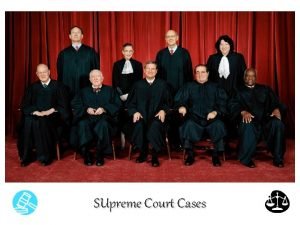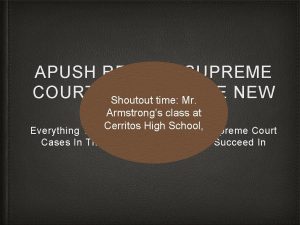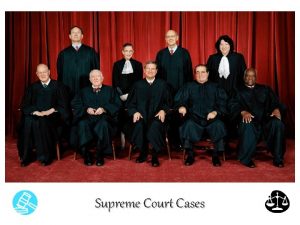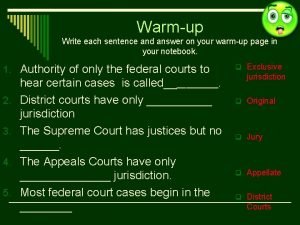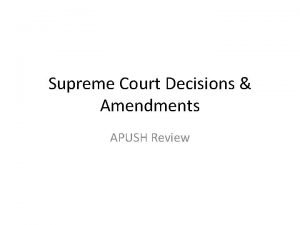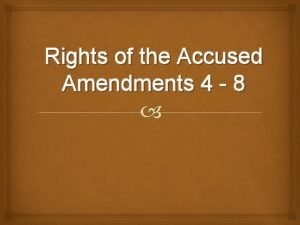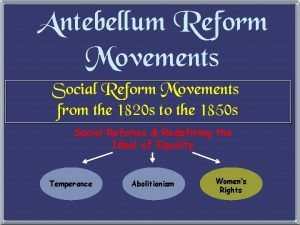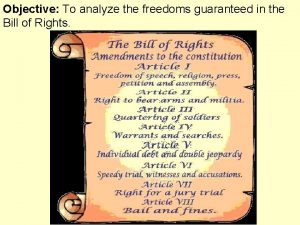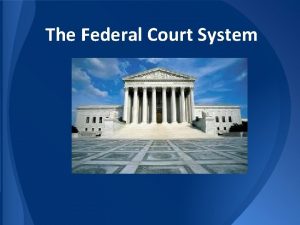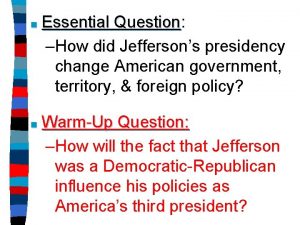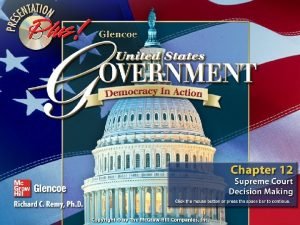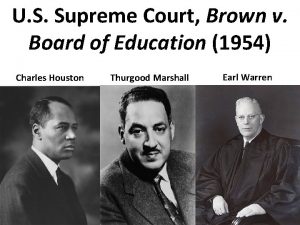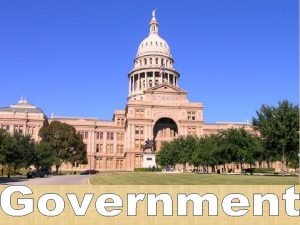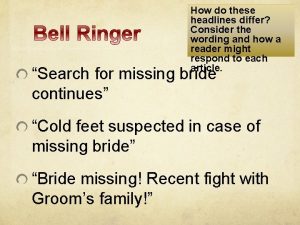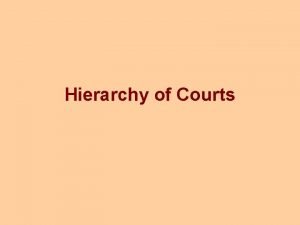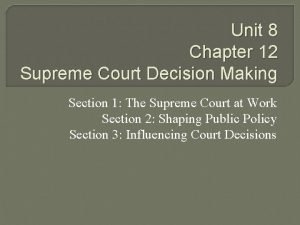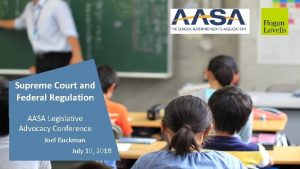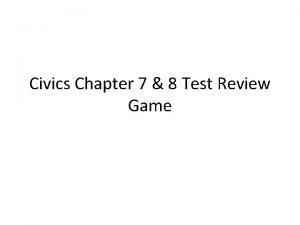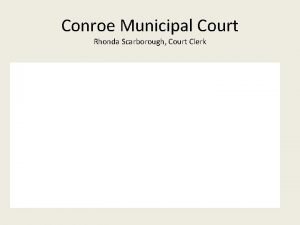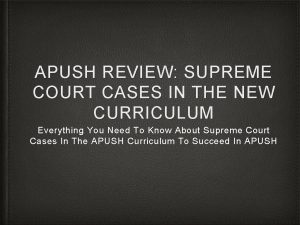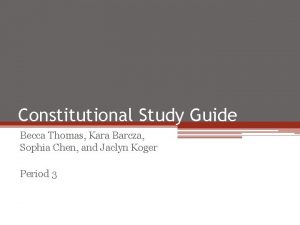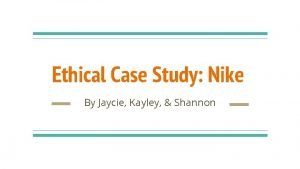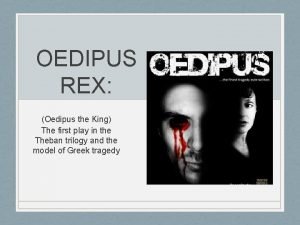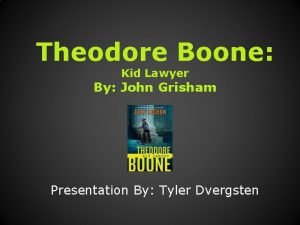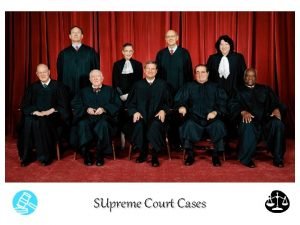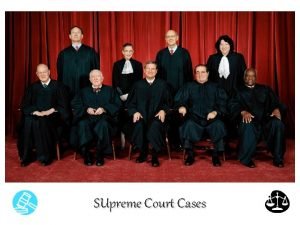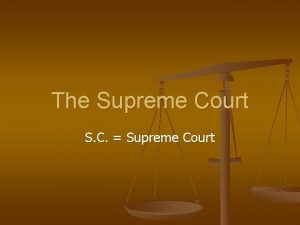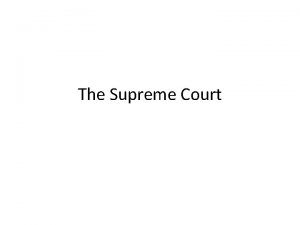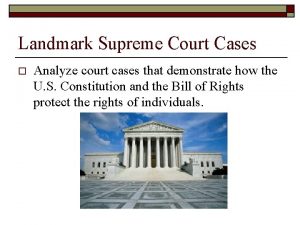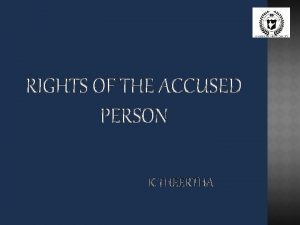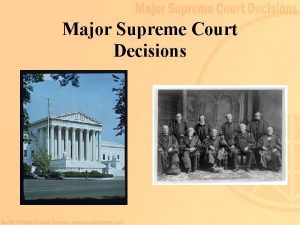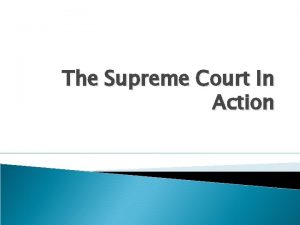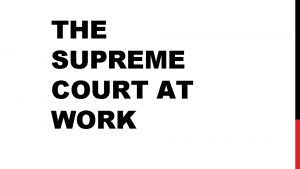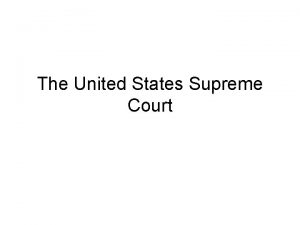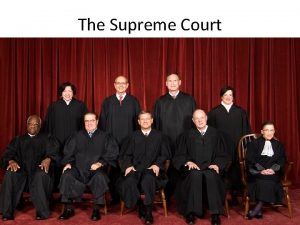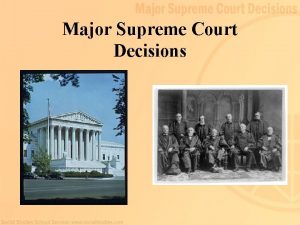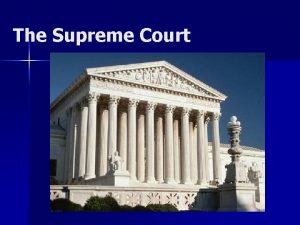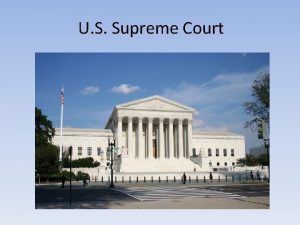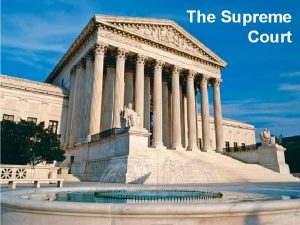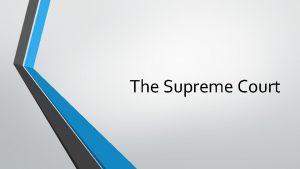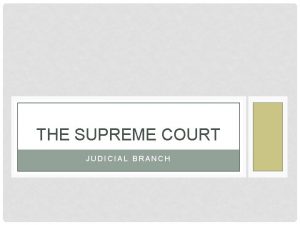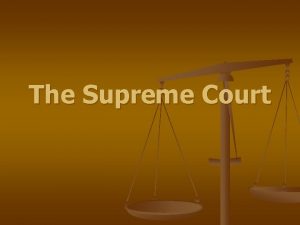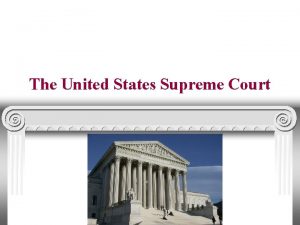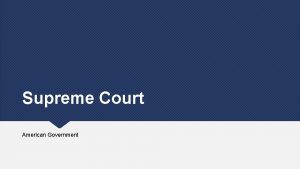Supreme Court Cases Rights of the Accused Ingraham






























- Slides: 30

Supreme Court Cases

Rights of the Accused Ingraham v. Wright Miranda v. Arizona Gideon v. Wainwright Mapp v. Ohio NJ v. TLO Vernonia v. Acton

Ingraham v. Wright (1977) A 14 year old student was accused of failing to promptly do as the teacher asked. He was taken to principle to be spanked with a spanking paddle. He refused and was held down and spanked 20 times. The Court held the Constitution's prohibition against cruel and unusual punishment does not apply to the corporal punishment of children in public schools

Miranda v. Arizona (1966) Ernesto Miranda was charged with rape and kidnapping. After two-hours of interrogation he signed a confession. Supreme Court ruled that detained criminal suspects, prior to police questioning, must be informed of their constitutional right to an attorney and against selfincrimination The Court ruled that the prosecution could not introduce the confession as evidence because the police had failed to first inform Miranda of his right to an attorney and against self-incrimination.

Gideon v. Wainwright (1963) Gideon was charged with breaking and entering and stealing money. He was unable to afford an attorney. Florida law only appointed counsel in capital cases. Court held the 6 th amendment right to counsel is essential to a fair trial and applies to the states. Those charged with felonies must be appoint an attorney if can not afford to hire an attorney.

Mapp v. Ohio (1961) Police were searching for a bombing subject in Ms. Mapp’s home. Upon her refusal to allow the police to search her home, the police presented her with a a fake warrant. The police found obscene materials and Ms. Mapp was charged. Case established the exclusionary rule Evidence obtained in violation of the 4 th amendment may not be used in state law criminal prosecutions.

New Jersey v. TLO (1985) TLO was caught smoking in the bathroom at school. School officials searched her purse and found cigarettes, marijuana, and a list of names that owed her money. TLO claimed the exclusionary rule prevented the evidence from the search be admitted. Court held the School setting requires some easing of the restrictions to which searches by public authorities are ordinarily subject Court held the school officials only needed reasonable suspicion, a more lenient standard, rather than probable cause to perform a search.

Vernonia v. Acton (1994) School district adopted drug testing plan for student athletes. The 4 th protects against expectation of privacy. The students are children and school acts in a custodial manner, therefore students have a lower expectation of privacy. The slight invasion of privacy was insignificant and did not override the school’s interest in deterring drug use.

Abortion and Reproduction Griswold v. Connecticut Roe v. Wade Planned Parenthood v. Casey

Griswold v. Connecticut (1965) A Connecticut statute prevented the use of any drug that prevented contraception. A Planned Parenthood executive opened a birth control clinic and was arrested. Though the Constitution does not explicitly protect a general right to privacy, the Bill of Rights does create zone of privacy. The Constitution protected the right to martial privacy.

Roe v. Wade (1971) A Texan women brought suit to challenge a Texas statute that criminalized all abortions except those performed for reasons regarding the mother’s health. The right to privacy includes a woman’s right to decide to terminate her pregnancy. While the court recognized the women’s right to choose, there was the competing interest of the mother’s health and life of the fetus Court set out a trimester framework During the first trimester the decision must be left to the mother During the second trimester the state could regulate abortion based on the mother’s health During the third trimester the fetus is considered viable and the state may pass laws to restrict and prohibit abortion

Planned Parenthood v. Casey (1992) Pennsylvania Abortion Control Act required women give informed consent and a 24 hour waiting period before getting an abortion. It also required spousal approval. The Court reaffirmed the constitutional right to an abortion, but states may pass laws affecting the first trimester for concerns to a mother’s health. However, states can not pass regulations that impose a substantial obstacle that prevent a women from obtaining a legal abortion. Court held waiting period not an undue burden, but spousal consent was.

Equal Protection of Law Plessy v. Ferguson Brown v. Board of Education Korematsu v. US

Plessy v. Ferguson (1896) Plessy was 1/8 black. He bought a train ticket and sat in a white-only car. He was arrested, tried, and convicted for alleging a state statute. He filed suit against the judge in the trial. The Court ruled that the equality created by the 14 th amendment extended only as far as political and civic rights, not social rights. The Court rejected Plessy’s argument because both blacks and whites were given equal facilities and equally punished for violating the law.

Brown v. Board of Education (1954) Brown was the parent of a child denied access to Topeka’s white school. Court held that racial segregation of children in public schools violated the Equal Protection Clause. Racial segregation in schools is inherently unequal and always unconstitutional. Public education is an essential component of public life.

Korematsu v. US (1944) Japanese internment camps were set up. Fred Korematsu refused to leave his home. Court stated that legal restrictions that curtail the rights of a single group are suspect and subject to the strictest scrutiny. Court decided nation’s security concerns outweighed Constitution’s promise of equal rights. Case established strict scrutiny. Case has not been explicitly overruled. A formal apology has been issued and reparations paid.

First Amendment Religion Engel v. Vitale Lemon v. Kurtzman Speech Tinker v. Des Moines Hazelwood v. Kuhlmeier Johnson v. Texas Bradenburg v. Ohio Press NY Times v. Sullivan Petition

Engle v. Vitale (1962) Case brought by Jewish families of students in NY public school regarding a voluntary prayer that the board made with reference to “Almighty God. ” Plaintiffs contended the prayer violated the Establishment Clause. Court held that government-written prayers were not to be recited in public schools and amounted to the establishment of religion.

Lemon v. Kurtzman (1971) Pennsylvania law allowed state superintendent to reimburse nonpublic schools for teachers that taught secular subjects. It allowed state funding or church institutions Court established a 3 prong test to determine if violating Establishment Clause; “Lemon test” Government action has a secular purpose Not have a primary effect of advancing or inhibiting religion Not result in excessive government entanglement [If any prong violated, government actions deemed unconstitutional] Court held statute to be unconstitutional.

Tinker v. Des Moines (1968) Students decided to wear black armbands to protest the Vietnam war. There students were suspended. Students sued the school for violating their right to expression. Court held the armbands were an example of symbolic speech. In order to justify the suppression of speech, the school officials must prove that the conduct in question would “materially and substantially interfere” with the operation of the school.

Hazelwood v. Kuhlmeier (1986) School newspaper was written and edited by students. Principle received proofs and did not approve of two stories. The two stories (one on teen pregnancy and one on divorce) were pulled from the paper. The editor filed suit alleging a first amendment violation. Court held that school-sponsored activities are not protected from administrative censorship. School could regulate student speech, “so long as their actions are reasonably related to legitimate pedagogical concerns. ”

Johnson v. Texas (1989) Johnson burnt flag in protest. Charged with violating Texas statute that prohibited vandalizing respected objects. Court held that speech does not end at the spoken word. Johnson’s actions were considered to be expressive conduct. Look at whether intent was to convey a message and if message understood Court held speech was protected.

Bradenburg v. Ohio (1969) Bradenburg was a KKK member. He spoke at a rally and used derogatory language. He was convicted of violating a law that made advocating crime of violence unlawful. Court held Bradenburg’s speech was protected and created the “imminent lawless action test” Speech can be prohibited if it is "directed at inciting or producing imminent lawless action” and is "likely to incite or produce such action. ”

NY Times v. Sullivan (1964) NY Times ran an advertisement that described actions against civil rights protestors which were not all accurate. The Court held that a public official suing for defamation must prove the statement was made with actual malice. Malice = knowledge or reckless lack of investigation Plaintiff in defamation case must prove the publisher of statement knew the statement was false or acted in reckless disregard of its truth.

Limits on Speech Although there is a first amendment right to freedom of speech, there are limits on speech. Limits include: Content based Imminent lawless action Time, place, manner restrictions Fighting words Obscenity Libel v. Slander Libel – written defamatory speech Slander – spoken defamatory speech

Freedom of Speech Pure Speech - face-to-face discussions, speeches at public meetings, classroom debates, and most things said on television and radio highest degree of protection Speech Plus Action -may take the form of marching, singing, picketing, or chanting slogans Symbolic speech -actions and objects replace words in conveying ideas Libel v. Slander

National Socialist Party of America v. Village of Skokie Facts of the case: The National Socialist Party of America, a neo-Nazi group, planned a march in the town of Skokie, Illinois. Many Skokie residents were Holocaust survivors. Frank Collin originally had proposed a march in Marquette Park on Chicago's southwest side where their headquarters were located. The Park District asked for a huge insurance bond to indemnify them against any damage caused by the anticipated violence hoping that this requirement would dissuade them from marching. The National Socialist Party of America then threatened to march in Skokie. Question: Does the ban on marching in Skokie violate a groups right to peaceably assemble? T Dealing with freedom of assembly.

National Socialist Party of America v. Village of Skokie The Illinois Supreme Court allowed the National Socialist Party of America to march when it ruled that the use of the swastika is a symbolic form of free speech entitled to First Amendment protections and determined that the swastika itself did not constitute "fighting words. "

Regents of the University of California v. Bakke Facts: Allan Bakke, a thirty-five-year-old white man, had twice applied for admission to the University of California Medical School at Davis and was rejected both times. The school reserved sixteen places in each entering class of one hundred for "qualified" minorities, as part of the university's affirmative action program. Bakke's qualifications exceeded those of any of the minority students admitted in the two years Bakke's applications were rejected. Bakke contended that he was excluded from admission solely on the basis of race Issue: Did the University of California violate the Fourteenth Amendment's equal protection clause by practicing an affirmative action policy that resulted in the repeated rejection of Bakke's application for admission to its medical school?

Holding: The Court struck down the University’s policy as an unconstitutional violation of the equal protection clause. Reasoning: A state may constitutionally consider race as a factor in its university admissions to promote educational diversity, but only if considered alongside other factors and on a case-by-case basis. California's use of racial quotas in this case, however, did not meet those requirements and violated the Constitution's Equal Protection Clause, which forbids a state from denying "to any person within its jurisdiction the equal protection of the laws. ”
 Insular cases apush
Insular cases apush Schechter poultry v us apush
Schechter poultry v us apush Supreme court cases graphic organizer answers
Supreme court cases graphic organizer answers How cases reach the supreme court worksheet answers
How cases reach the supreme court worksheet answers Apush supreme court cases
Apush supreme court cases Is there a basketball court above the supreme court
Is there a basketball court above the supreme court Amendments 4-8
Amendments 4-8 Sarah ingraham antebellum
Sarah ingraham antebellum Oyez ingraham v wright
Oyez ingraham v wright Supreme court
Supreme court Us circuit court map
Us circuit court map John marshall supreme court
John marshall supreme court Supreme court does
Supreme court does Supreme court
Supreme court The supreme court change
The supreme court change Have supreme court
Have supreme court What do these headlines say about how the supreme court
What do these headlines say about how the supreme court Which precedent was established by the supreme court
Which precedent was established by the supreme court Jurisdiction of high court
Jurisdiction of high court The supreme court
The supreme court Vocabulary activity 12 supreme court decision making
Vocabulary activity 12 supreme court decision making John marshall supreme court
John marshall supreme court Supreme court does
Supreme court does The u.s. supreme court works chiefly as a(n)
The u.s. supreme court works chiefly as a(n) Criminal cases vs civil cases
Criminal cases vs civil cases Conroe municipal court
Conroe municipal court Escobedo v illinois apush
Escobedo v illinois apush 3rd amendment court cases
3rd amendment court cases Nike accused of tolerating sweatshops
Nike accused of tolerating sweatshops Sophocles oedipus rex summary
Sophocles oedipus rex summary Theodore boone kid lawyer summary
Theodore boone kid lawyer summary
